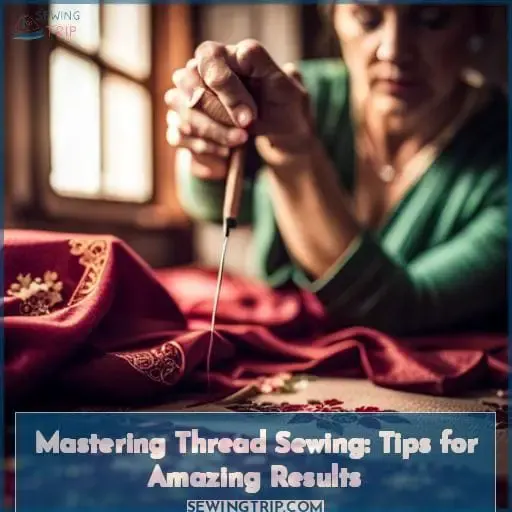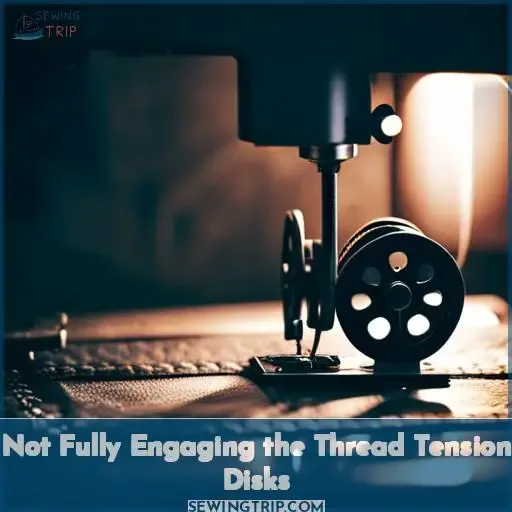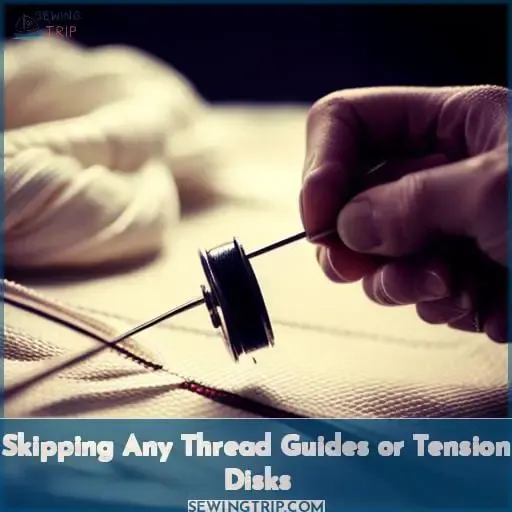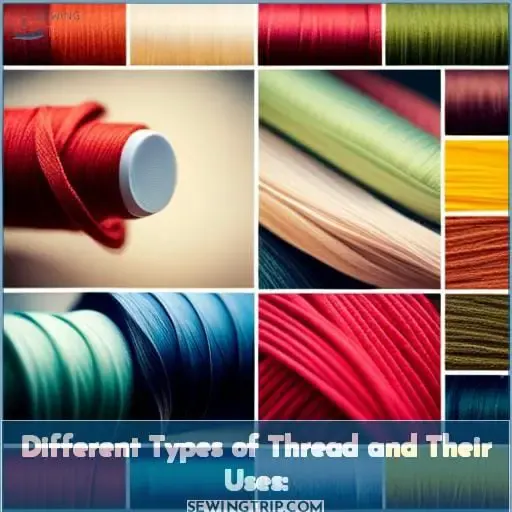This site is supported by our readers. We may earn a commission, at no cost to you, if you purchase through links.
 Are you looking to master thread sewing and achieve amazing results? With a little practice and these expert tips, you’ll be well on your way! Whether it’s cotton or polyester, silk or nylon, understanding the different types of threads available is key to creating beautiful fabric designs.
Are you looking to master thread sewing and achieve amazing results? With a little practice and these expert tips, you’ll be well on your way! Whether it’s cotton or polyester, silk or nylon, understanding the different types of threads available is key to creating beautiful fabric designs.
From skipping any thread guides or tension disks – which can result in uneven stitching – to selecting the right type of thread for each project, learn how to make every stitch count with our guide on mastering thread sewing.
Table Of Contents
- Key Takeaways
- Not Fully Engaging the Thread Tension Disks
- Skipping Any Thread Guides or Tension Disks
- Different Types of Thread and Their Uses:
- Cotton Thread: Commonly Used for General Sewing Projects, Especially for Natural Fibers Like Cotton and Linen
- Polyester Thread: Known for Its Strength and Durability, Often Used for Sewing Synthetic Fabrics and Knits
- Silk Thread: Used for Delicate and Fine Fabrics, as Well as for Hand Sewing and Embroidery
- Nylon Thread: Known for Its High Strength, Elasticity, and Resistance to Abrasion, Often Used for Heavy-duty Sewing Such as Upholstery or Outdoor Gear
- Metallic Thread: Used for Decorative Stitching and Embroidery, Adding a Shimmering Effect to the Fabric
- Heavyweight Fabrics: Use a Strong Thread Like Nylon or Polyester, Use a Larger Needle Size, and Adjust the Tension for Thicker Threads
- Conclusion
Key Takeaways
- Use the appropriate thread type for different sewing projects.
- Adjust tension for flawless stitching and to avoid stitch issues.
- Regularly clean and maintain threads to prevent breakage.
- Experiment with different thread colors to add depth and dimension in your creations.
Not Fully Engaging the Thread Tension Disks
You must ensure you’re fully engaging the tension disks to achieve flawless, professional stitching results. Proper tension adjustment is crucial for troubleshooting issues and preventing thread jams while sewing.
When threading your machine, follow the proper technique for your model, like the Sew Inspiration 700 or Crafty Mini. Make sure to pass the thread through all necessary guides and loops, including those on the tension disks.
Doing so allows for even tension distribution throughout your stitches, resulting in clean lines and balanced threads on both fabric sides.
Another aspect to consider is bobbin tension. Improper settings can lead to uneven stitch quality or skipped stitches. Take time to understand how each component works together by referring back to your machine manual or seeking experienced sewer advice.
This’ll help you troubleshoot any tension issues and ensure a professional-looking finished product. With proper threading technique, you can harness your machine’s hidden power and unleash awe-inspiring craftsmanship.
Skipping Any Thread Guides or Tension Disks
Now that you’ve learned about the importance of fully engaging the thread tension disks, let’s move on to another common mistake – skipping any thread guides or tension disks.
While it may seem tempting to take shortcuts and skip these steps, doing so can greatly affect your sewing results. Thread guides and tension disks are designed to help control the flow of thread through your machine, ensuring even stitches and preventing tangles or snags.
By bypassing these crucial components, you risk compromising the overall quality of your work. To master thread control and achieve amazing sewing results, it’s essential that you utilize all available tools at your disposal.
Take the time to properly engage each guide and disk to maintain consistent tension throughout every stitch.
Discover troubleshooting techniques for handling thread tensions.
Explore new possibilities by sewing without relying on guides.
Master advanced skills in controlling threads with precision.
Remember: Skipping those vital tension disks will only hinder your progress towards becoming a skilled seamstress!
Different Types of Thread and Their Uses:
Getting started with threading your sewing machine! The right thread is crucial for beautiful, long-lasting seams, whether you are working with delicate silks or heavy canvas. Cotton and polyester threads handle most fabrics, while slippery metallics add sparkle for decorative details.
For heavy fabrics, opt for a strong nylon or polyester thread in a larger needle to avoid breakage. Adjust the tension as needed for smooth top and bottom stitches. With the proper tools, you’ll be ready to sew amazing creations on any material.
Cotton Thread: Commonly Used for General Sewing Projects, Especially for Natural Fibers Like Cotton and Linen
My friend, cotton thread cradles your stitches with a soft, reassuring touch. It’s the go-to choice for general sewing projects, especially when working with natural fibers like cotton and linen. With its versatility and strength, it ensures sturdy seams that withstand daily wear and tear.
Experimenting with different shades of thread can add depth and dimension to your creations. Remember to store your threads properly in order to prevent tangling or damage. And don’t forget about thread tension! Troubleshooting tips will help you avoid any issues such as breakage or loose stitches.
| Thread Tension: Troubleshooting Tips | Choosing the Right Thread Weight | Thread Colors: Experimenting with Different Shades |
|---|---|---|
| Adjust tension settings on your machine if needed | Consider fabric weight when selecting a suitable thread weight | Play around by using contrasting or complementary colors |
Thread maintenance’s also crucial in preventing breakage during sewing sessions – ensure that you regularly clean out lint from both the machine’s bobbin case area as well as from inside the needle plate cover.
Remember these key points:
- Choose cotton thread for natural fiber fabrics.
- Store threads properly.
- Adjust tension settings accordingly.
By following these guidelines, you’ll be able to sew amazing creations effortlessly while avoiding any unwanted mishaps along the way!
Polyester Thread: Known for Its Strength and Durability, Often Used for Sewing Synthetic Fabrics and Knits
Polyester thread is known for its strength when sewing knits because it holds up well. The benefits of using polyester thread are numerous – it’s durable, resistant to abrasion, and doesn’t shrink or stretch like other threads.
When stitching with polyester, remember to adjust your thread tension accordingly for optimal results. Its strength ensures that your seams won’t burst when working on synthetic fabrics or knits.
Silk Thread: Used for Delicate and Fine Fabrics, as Well as for Hand Sewing and Embroidery
You’d use silk thread for delicate fabrics like silk or chiffon since it’s smooth and won’t snag the material. The sheen of silk thread is ideal for satin stitch embroidery on fine linens or embellishing a bridal gown.
Maintaining proper tension is key when sewing slippery fabrics with silk, keeping stitches tiny and even. For sheer chiffon blouses, choose lightweight silk that won’t show through the fabric. Silk thread in a matching color creates invisible hand-sewn hems on silks and satins.
Finishing seams with silk prevents fraying on georgette. With care, silk thread helps you beautifully construct delicate creations.
Nylon Thread: Known for Its High Strength, Elasticity, and Resistance to Abrasion, Often Used for Heavy-duty Sewing Such as Upholstery or Outdoor Gear
When tackling heavy-duty sewing projects like upholstery or outdoor gear, nylon thread is your go-to choice due to its remarkable strength and resilience. Its high strength and elasticity make it perfect for holding together fabrics that need extra durability.
Whether you’re repairing a torn camping tent or creating a sturdy cushion cover, using nylon thread will ensure that your project stands up to the test of time.
Metallic Thread: Used for Decorative Stitching and Embroidery, Adding a Shimmering Effect to the Fabric
To achieve a stunning and eye-catching effect on your fabric, try using metallic thread for decorative stitching and embroidery. Choosing the right metallic thread can make all the difference in creating beautiful embellishments that sparkle and shine.
When working with metallic thread, it’s important to adjust your machine’s tension settings to avoid issues such as breakage or tangling. Experiment with different techniques like couching or blending metallic threads with other types of threads for unique designs that truly stand out.
Varying your stitch length and width can also add interest. Consider trying a zigzag stitch or other decorative stitches when using metallic thread. Play around with different thread thicknesses and textures for metallic highlights on your project.
With the right technique, metallic thread can take your sewing projects to a glamorous new level.
Heavyweight Fabrics: Use a Strong Thread Like Nylon or Polyester, Use a Larger Needle Size, and Adjust the Tension for Thicker Threads
With these monstrous needles and mega-thick nylon threads, you’ll charge through those heavyweight fabrics like a rhino! When working with heavy materials such as denim or canvas, it’s important to use a strong thread like nylon or polyester.
Make sure to also adjust the tension on your sewing machine for thicker threads. Don’t forget to pair your heavyweight fabric with a matching foot and sharp needles for smooth stitching. To prevent fraying, consider cutting bias strips or using fusible interfacing when hemming thicknesses of fabric.
Conclusion
Time to take your thread sewing skills to the next level! With a few simple tips, you can create amazing results that’ll have your friends and family in awe.
Engaging the thread tension disks and choosing the right type of thread for your project are crucial.
Whether you’re working with cotton, polyester, silk, nylon, metallic, or heavyweight fabrics, adjusting the tension and selecting a larger needle size for heavier threads can make a huge difference.
So, don’t be intimidated by thread sewing. With a little practice, you’ll be making amazing creations in no time!









